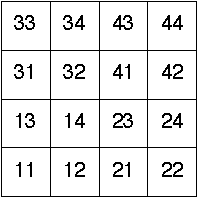
| Coca-Cola | {{0,4,0,0},{3,22,44,4},{0,44,109,8},{1,2,9,0}} | |
| Kellogg | {{0,0,1,1},{0,1,12,9},{2,16,137,28},{0,6,32,5}} | |
| Nokia | {{0,9,3,1},{6,105,44,4},{5,43,21,2},{2,2,3,0}} | |
| Motorola | {{0,0,1,0},{0,7,33,5},{1,35,129,16},{0,3,18,2}} | |
| Microsoft | {{0,2,1,1},{0,21,38,9},{1,37,100,13},{3,8,12,4}} | |
| Chase | {{1,4,1,1},{2,62,55,2},{4,51,58,3},{0,3,3,0}} |